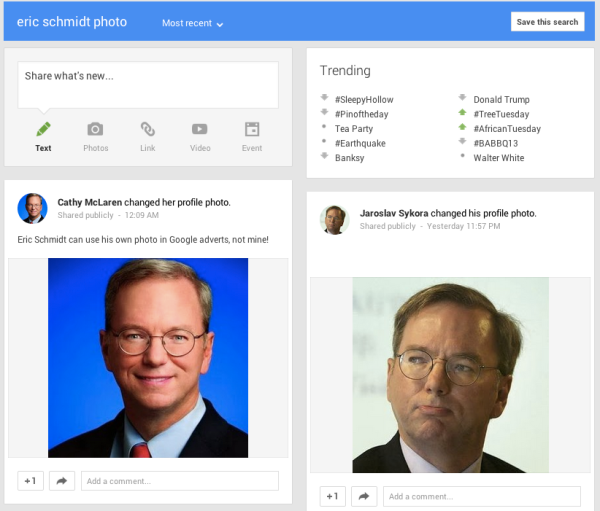No, Eric Schmidt’s Face Isn’t All Over Google+ In Protest Over Shared Endorsement Ads
It sounded huge. Angered by Google expanding the use of social profile information in advertising, Google+ users were changing their profile pictures to that of Google executive chairman Eric Schmidt in protest. So went several reports. The reality is practically no one is doing this. For the few who are, good news. Google’s rules about […]

Google’s Shared Endorsements Ads Expand
On Friday, Google announced that it would be expanding the use of “Shared Endorsements” in ads. Google already had been using the pictures and names of people who make use of its Google+ social networking service in ads for over two years. But in the near future, Google might make further use of social actions people do, such using comments they make about products, in ads.
Our previous story, All About Google’s New “Shared Endorsement” Ads, explains this in more detail. Despite the fact that Google had already been using pictures and names in ads, Friday’s announcement was seen by some — perhaps many — as a dramatic new change, one that had Google mimicking what Facebook does with its Sponsored Stories. And some were not happy about it.
Protest Makes Headlines
Yesterday, news of protests appeared. CNET, The Huffington Post and even the BBC all ran stories about how people were changing their profile pictures on Google+ to that of Schmidt, so that it would be Schmidt’s picture associated with any ads, not their own.
“Evidence of a small movement,” CNET called it, with the most subdued of the stories I’ve seen — but still, a movement?
The BBC said Google faced a “backlash” from “many” protesting over the change, though it didn’t explain or document how this “many” were protesting. In terms of profile picture changes, it said “some” had done so.
Then there was the Huffington Post: “The few who use still use Google’s Facebook clone protested the move by switching their Google+ profile pictures,” it wrote, suggesting that practically no one uses Google+ but of those who do, everyone was upset.
But Protesters Are Hard To Find
As best I can tell, practically no one out of the hundreds of millions that Google says actively use Google+ are doing this. That doesn’t make for a great headline, such as the Huffington Post had, but it’s the reality.
Yes, there are a few. The best way to spot them is to do a search on Google+ for “eric schmidt photo,” as shown below:
When I did that, I counted about 50 people in all. Even if you doubt Google’s official figures of Google+ usage (and the Huffington Post clearly does, despite third-party stats much more generous to Google+), that’s still a tiny handful if it has only one million users. Handful, in fact, itself might be an overstatement.
As a regular Google+ user, who follows plenty of people, I certainly didn’t find “Eric Schmidt’s Face Shows Up All Over Google+ In Protest Of New Ads,” as the Huffington Post headline put it, during my regular use of the service. I had to go deliberately hunting to find examples.
In some ways, perhaps it’s even a sign that Google+ has matured into a service substantial enough that tiny protests can get headline coverage. It’s not uncommon that Facebook makes some change, which causes someone to start a Facebook group against it, which in turn gets magnified into a seemingly large protest. Congrats, Google. You’ve made it.
Can You Use Someone Else’s Picture?
Of course, there is a chance that the tiny number who are indeed protesting this way might grow. If so, would it even be allowed under the Google+ profile rules?
That’s the question I was interested in when I originally set-out to do this story, following on the reports suggesting the protests were more wide-spread. Google has some pretty serious rules requiring people to use their real identities on Google+. Do those extend to using real pictures of themselves? Could using someone else’s picture, such as Schmidt’s, get you kicked off the service?
If so, Google’s not saying. The company wouldn’t comment on whether this type of protest in particular, or using someone else’s picture in general, is a policy violation. Rather, it just directed me to its page about impersonations.
That page specifically warns against using company logos as profile pictures. Aside from that, the rules are really focused against profiles that deliberately try to deceive or trick people into thinking they’re viewing a profile that represents someone, when it doesn’t.
So, if you’re changing your picture to Eric Schmidt in protest over Google’s expansion of social endorsements, you’re probably on safe ground, as long as you don’t also change other parts of your profile to make people believe you’re him.
One caveat. If you use Google Authorship to have your picture appear next to content you’ve created, the rules say you need a “recognizable headshot.” I suspect it’s considered inherent this means one that is of you. Use someone else’s picture, and you might find authorship potentially gets disabled for you, if Google spots it.
As said, Google’s use of images in social ads isn’t new. Google’s done this for over two years. But if you dislike the expansion to make further use of your comments and other social actions, there’s another form of protest you can do. Simply opt-out of having your activities used this way. More about that, and the program, in our story below:
Opinions expressed in this article are those of the guest author and not necessarily MarTech. Staff authors are listed here.
Related stories
